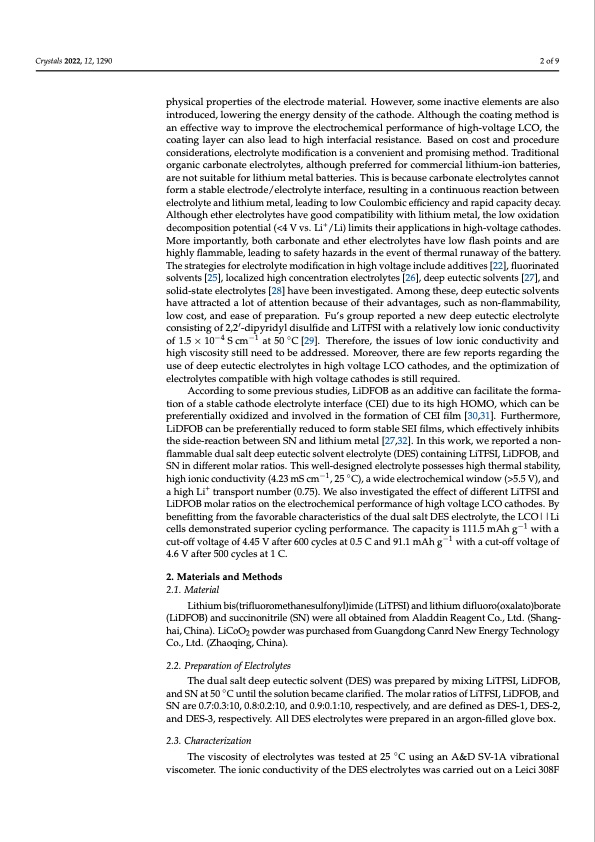
PDF Publication Title:
Text from PDF Page: 002
Crystals 2022, 12, 1290 2 of 9 physical properties of the electrode material. However, some inactive elements are also introduced, lowering the energy density of the cathode. Although the coating method is an effective way to improve the electrochemical performance of high-voltage LCO, the coating layer can also lead to high interfacial resistance. Based on cost and procedure considerations, electrolyte modification is a convenient and promising method. Traditional organic carbonate electrolytes, although preferred for commercial lithium-ion batteries, are not suitable for lithium metal batteries. This is because carbonate electrolytes cannot form a stable electrode/electrolyte interface, resulting in a continuous reaction between electrolyte and lithium metal, leading to low Coulombic efficiency and rapid capacity decay. Although ether electrolytes have good compatibility with lithium metal, the low oxidation decomposition potential (<4 V vs. Li+/Li) limits their applications in high-voltage cathodes. More importantly, both carbonate and ether electrolytes have low flash points and are highly flammable, leading to safety hazards in the event of thermal runaway of the battery. The strategies for electrolyte modification in high voltage include additives [22], fluorinated solvents [25], localized high concentration electrolytes [26], deep eutectic solvents [27], and solid-state electrolytes [28] have been investigated. Among these, deep eutectic solvents have attracted a lot of attention because of their advantages, such as non-flammability, low cost, and ease of preparation. Fu’s group reported a new deep eutectic electrolyte consisting of 2,2′-dipyridyl disulfide and LiTFSI with a relatively low ionic conductivity of 1.5 × 10−4 S cm−1 at 50 ◦C [29]. Therefore, the issues of low ionic conductivity and high viscosity still need to be addressed. Moreover, there are few reports regarding the use of deep eutectic electrolytes in high voltage LCO cathodes, and the optimization of electrolytes compatible with high voltage cathodes is still required. According to some previous studies, LiDFOB as an additive can facilitate the forma- tion of a stable cathode electrolyte interface (CEI) due to its high HOMO, which can be preferentially oxidized and involved in the formation of CEI film [30,31]. Furthermore, LiDFOB can be preferentially reduced to form stable SEI films, which effectively inhibits the side-reaction between SN and lithium metal [27,32]. In this work, we reported a non- flammable dual salt deep eutectic solvent electrolyte (DES) containing LiTFSI, LiDFOB, and SN in different molar ratios. This well-designed electrolyte possesses high thermal stability, high ionic conductivity (4.23 mS cm−1, 25 ◦C), a wide electrochemical window (>5.5 V), and a high Li+ transport number (0.75). We also investigated the effect of different LiTFSI and LiDFOB molar ratios on the electrochemical performance of high voltage LCO cathodes. By benefitting from the favorable characteristics of the dual salt DES electrolyte, the LCO||Li cells demonstrated superior cycling performance. The capacity is 111.5 mAh g−1 with a cut-off voltage of 4.45 V after 600 cycles at 0.5 C and 91.1 mAh g−1 with a cut-off voltage of 4.6 V after 500 cycles at 1 C. 2. Materials and Methods 2.1. Material Lithium bis(trifluoromethanesulfonyl)imide (LiTFSI) and lithium difluoro(oxalato)borate (LiDFOB) and succinonitrile (SN) were all obtained from Aladdin Reagent Co., Ltd. (Shang- hai, China). LiCoO2 powder was purchased from Guangdong Canrd New Energy Technology Co., Ltd. (Zhaoqing, China). 2.2. Preparation of Electrolytes The dual salt deep eutectic solvent (DES) was prepared by mixing LiTFSI, LiDFOB, and SN at 50 ◦C until the solution became clarified. The molar ratios of LiTFSI, LiDFOB, and SN are 0.7:0.3:10, 0.8:0.2:10, and 0.9:0.1:10, respectively, and are defined as DES-1, DES-2, and DES-3, respectively. All DES electrolytes were prepared in an argon-filled glove box. 2.3. Characterization The viscosity of electrolytes was tested at 25 ◦C using an A&D SV-1A vibrational viscometer. The ionic conductivity of the DES electrolytes was carried out on a Leici 308FPDF Image | Non-Flammable Dual-Salt Deep Eutectic Electrolyte

PDF Search Title:
Non-Flammable Dual-Salt Deep Eutectic ElectrolyteOriginal File Name Searched:
crystals-12-01290-v2.pdfDIY PDF Search: Google It | Yahoo | Bing
Product and Development Focus for Salgenx
Redox Flow Battery Technology: With the advent of the new USA tax credits for producing and selling batteries ($35/kW) we are focussing on a simple flow battery using shipping containers as the modular electrolyte storage units with tax credits up to $140,000 per system. Our main focus is on the salt battery. This battery can be used for both thermal and electrical storage applications. We call it the Cogeneration Battery or Cogen Battery. One project is converting salt (brine) based water conditioners to simultaneously produce power. In addition, there are many opportunities to extract Lithium from brine (salt lakes, groundwater, and producer water).Salt water or brine are huge sources for lithium. Most of the worlds lithium is acquired from a brine source. It's even in seawater in a low concentration. Brine is also a byproduct of huge powerplants, which can now use that as an electrolyte and a huge flow battery (which allows storage at the source).We welcome any business and equipment inquiries, as well as licensing our flow battery manufacturing.| CONTACT TEL: 608-238-6001 Email: greg@salgenx.com | RSS | AMP |